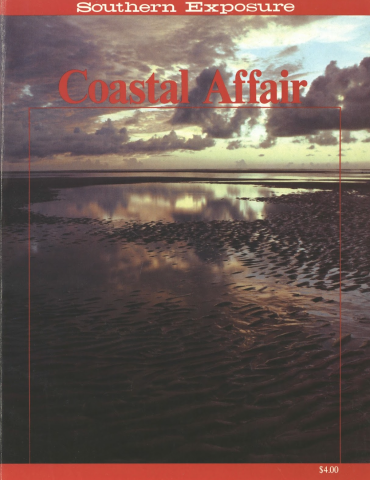Banker Ponies

This article originally appeared in Southern Exposure Vol. 10 No. 3, "Coastal Affair." Find more from that issue here.
Well, now you’ve heard of the banker ponies? Well, there were not only ponies — there were cows and sheep, too . . . and they just ran loose on the banks; nobody looked after them.
Now, a funny thing about it. This island [Harkers Island, North Carolina] was about 22 miles long, and they would migrate from one end to the other. Well, they’d go up to the north end, and by the time they’d get back, there’d be a little bit more grass, see? That would give it time to grow, and they’d just work back and forth, like that.
The cows would go right along with them. And so would the sheep. Generally, they kind of stayed together. You might look out there one day and see them about five miles up the beach; then the next day they’d be about two miles. The next day they’d pass you. But they had no shelter out there, no protection. Sometimes they might get behind a few sand dunes, but they were pretty well conditioned to the weather.
But one of the most fascinating things: If you’ll stop and think about it, a horse can dig. Now, those banker ponies, there was no one to look after them and trim their hoofs. You know, they would grow like a toenail or fingernail. And some of them would curl up, and they would actually split. And they would get sore feet and eventually, sometimes, they would get an infection and die. And occasionally they’d break off and they’d be all right. But anyway, when they’d get thirsty, those horses would start digging right out on the high part of the beach there someplace. And maybe there’d be one here and one here and three or four over there, scattered around, and just like a dog — clawing with their front paws, and pretty soon their belly would be on the ground and they’d be down in the hole.
And you’d see him get through, and another one would go down there and drink his fill. Well, all the time, the horses would drink first; the cows and sheep have split hoofs, so they can’t dig, and they’d just stand around and wait. When the horses got through, the cows would start drinking, and then when the cows got through, the sheep would drink. Then they’d migrate on down the beach. And the next day they’d start digging more holes. Well, the wind and the tide and everything would come in and cover them up.
Now, another fascinating thing about those animals: at times the mosquitoes were terrible out there. Usually we had wind, but you get down to the evening when the wind has calmed down, and in that marsh grass where it’s a little mucky and muddy, there’s millions of these little black mosquitoes, we call them. OK. They would get so bad that the poor animals just couldn’t get away from them. There was no relief in sight. And you know what they did? They’d go out in the Cape Lookout bight, in the salt water, and they’d go just as far out as they could to keep their nose and eyes above water. And, as the tide would go out, they’d keep going out a little farther; and as the tide would come in, they’d gradually keep coming in just enough to keep their nose and eyes so they could breathe. And you could look out there on an evening sometimes and see 500 or 600 heads just up above the water.
We had one boy at the Navy station, that, one of those cows was so pretty, and she had a calf, and she had a right nice-sized udder on her, and he decided, “Well, that cow’s so pretty, I’m going to get some feed and start feeding that thing and milking her.” Cause he had a kid or two. His name was Dabney, and I’ll never forget him as long as I live. He was from Alabama. And he caught this old cow and she was a pretty thing, and he bought some hay and he bought some cow feed. Brought it over there and started feeding that cow like a regular cow.
And the food was so rich the cow died in about two weeks. Just couldn’t stand it.
Tags
John D. Coble
John D. Coble, 1912, Former Lighthouse Keeper, Cape Lookout (1982)